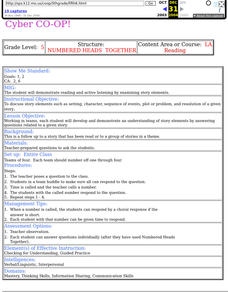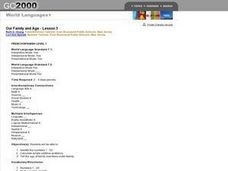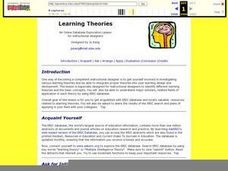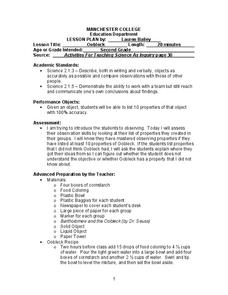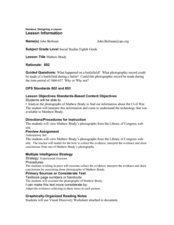Curated OER
Find Someone Who........
Fifth graders identify, describe, and classify lines, line segments, rays, and angles. When given a diagram of a line, they classify the line as perpendicular, parallel, intersecting, vertical, horizontal, and/or diagonal.
Curated OER
Pairs Check
Fifth graders add, subtract, multiply and divide whole numbers. While receiving coaching and praise from his/her partner, each student will multiply whole numbers (three digits by two digits).
Curated OER
Line Ups
Fifth graders describe the lunar cycle. develop an understanding of the order and phases of the moon. Each student in a team contributes orally in order to make a line up of the moon phases in order.
Curated OER
Roundtable
Fifth graders apply the Five Themes of Geography as they relate to the U.S., the world, and specific places in United States history. They recognize and label geographical locations on a map of the United States.
Curated OER
Numbered Heads Together
Fifth graders demonstrate reading and active listening by examining story elements. Working in teams, each student will develop and demonstrate an understanding of story elements by answering questions related to a given story.
Curated OER
Presentation of Our Family
Although there is no real lesson plan included here, you could easily recycle the idea! Get kids using vocabulary related to family, age, feelings, and nationality. Start by teaching basic vocabulary words and phrases (you'll need to...
Curated OER
Our Family and Age
Start by playing a song about numbers. "Sing, Dance, Laugh, and Eat Quiche" is suggested. Then, start counting things around the room. Introduce yourself, and have kids start to introduce themselves when they catch on to the vocabulary....
Curated OER
Learning Theories
Students access the ERIC database and search for the resources on learning theories. They use the features of ERIC to bookmark sources and then use Excel to create a summary of the database search.
Foreign Policy Research Institute
Project Terrorism
If you're looking for possible topics related to terrorism, or a list of online sources of information, you may want to take a look at this resource. However, it is too under-developed to be useful without additional work. The...
Curated OER
Parentheses
Point out the proper uses of parentheses with this informational handout! This resource explains how to use parentheses for side comments, numbers in a list, and citations of outside sources. Learners can read a series of examples for...
Curated OER
Pronoun Agreement
A 20-item worksheet calls for learners to write the correct pronoun to replace the underlined one in each sentence. Several of the sentence topics deal with bodily functions, mildly grisly subject matter, and social norms that may be of...
Curated OER
ESL: Adjectives-Find the Opposite
In this ESL adjective activity, learners read adjectives, then choose their opposites from drop down lists beside each one. Answers can be checked on line.
Curated OER
Chef for a Day
Learners make chocolate chip cookies. In this cooking lesson, students follow a recipe by doing each step in sequence.
Curated OER
What Is It?
Students explore the likelihood of events. In this logical thinking lesson, 3rd graders are given several scenarios and determine whether the possibility of the described event actually happening is likely, unlikely, or...
Curated OER
Oobleck
Second graders observe the properties of Oobleck. In this science and observation lesson plan, 2nd graders examine Oobleck and make a list of 10 properties that they notice. They explain their observations.
Curated OER
"Here Comes the Train"
Students read and explore the story, The Little Engine that Could, by Watter Piper.
Curated OER
How Can You See Which Soda Has More Sugar?
Sixth graders weigh regular and diet soda to see which one is heavier and therefore which one contains more sugar. In this soda lesson plan, 6th graders discover that regular soda contains more sugar because it weighs more.
Curated OER
Just the Facts, Jack
Third graders listen to music and discuss their responses to different styles separating their comments into facts and opinions. They evaluate a worksheet of statements by classifying the statements into fact and opinion.
Curated OER
Student Learning-Strengths Inventory
Students complete an online inventory to determine their strengths and weaknesses. They create graphs to show their results. They discover how they are unique from their classmates.
Curated OER
Dynamics
First graders review Frere Jacques and perform crescendos and decrescendos. In this music lesson plan, 1st graders also learn about the dynamics of music including piano, forte, mezzo piano, and mezzo forte.
Curated OER
Readers as Individuals
Sixth graders set and are encouraged to meet their reading goals and demonstrate knowledge of literary elements in this lesson.
Curated OER
Mathew Brady: Civil War
Eighth graders interpret historical evidence presented in primary resources. In this Civil War lesson, students analyze photographs taken by Mathew Brady.
Curated OER
Just Me and My Mom
First graders create predictions for the story, Just Me and My Mom. In this language arts lesson, 1st graders read and discuss the story. Additionally, students draw pictures of the events of the story to show who, what, where, and when....
Curated OER
What is the Function of Each Seed Part in the Growth of a Plant
Sixth graders investigate the parts of a seed by using a digital camera. In this botany lesson, 6th graders plant their own seeds in class and demonstrate the necessary attributes for growing a plant. Students utilize a...
Other popular searches
- Multiple Intelligences
- Emotional Intelligence
- Artificial Intelligence
- Emotional Intelligence Games
- Multiple Intelligences Math
- Multiple Intelligence Theory
- Dolphin Intelligence
- Multiple Intelligences Model
- Multiple Intelligences Esl
- Musical Intelligence
- Intelligence Agencies
- Kinesthetic Intelligence




